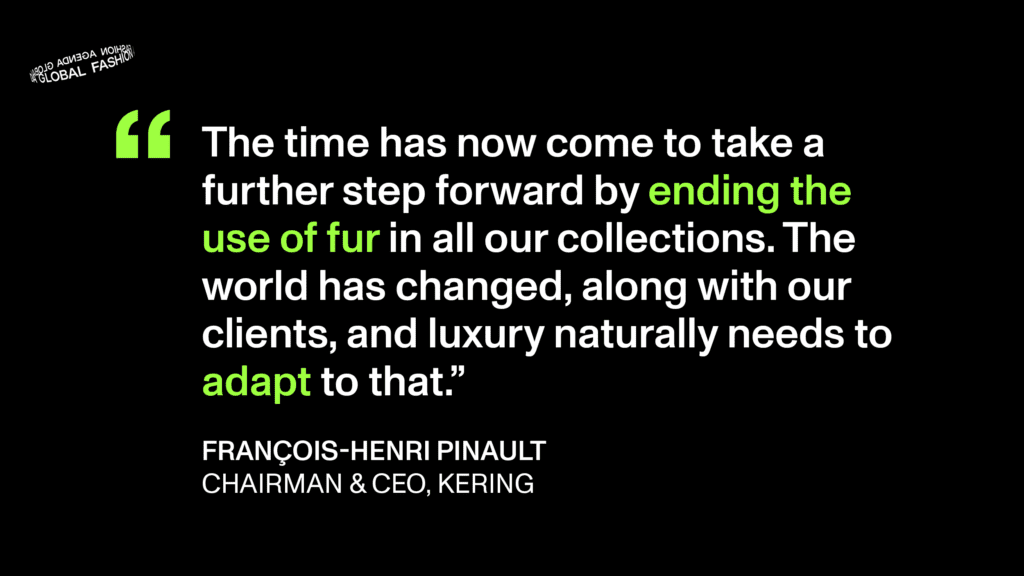The Shift to Fur-Free Fashion


What was once synonymous with luxury fashion, the industry is increasingly moving away from fur, as it reckons with both the ethical and environmental implications of the material.
The anti-fur movement has long since been established (cast your mind back to the Peta campaigns of the 1990s which enlisted stars such as Naomi Campbell and Christy Turlington declaring they would “rather go naked than wear fur.”), and companies are increasingly following suit by pledging to rid themselves of fur entirely. Consistent with an overall shift in the fashion sector and a growing commitment landscape from brands, in September of this year, Global Fashion Agenda’s Strategic Partner, Kering, announced that it was going completely fur-free.
Speaking to this decision, François-Henri Pinault, Chairman & CEO of Kering, shared: “For many years, Kering has sought to take the lead in sustainability, guided by a vision of luxury that is inseparable from the very highest environmental and social values and standards. When it comes to animal welfare, our Group has always demonstrated its willingness to improve practices within its own supply chain and the luxury sector in general. The time has now come to take a further step forward by ending the use of fur in all our collections. The world has changed, along with our clients, and luxury naturally needs to adapt to that.”
Following on from Gucci declaring fur to be “outdated” in 2017, all the Group’s Houses, notably Balenciaga, Bottega Veneta, Alexander McQueen, Brioni and Saint Laurent, have progressively decided to take this step.
Kering’s move away from fur is indicative of the industry’s evolving stance on the material and is in line with other high-end fashion houses and retailers such as Prada, Michael Kors, Versace, Canada Goose, Mytheresa, Yoox Net-A-Porter, Burberry and Chanel who have committed to going fur-free in recent years. Earlier adopters of the fur-free commitments include Calvin Klein in 1994, Ralph Lauren and Tommy Hilfiger in 2007, and Armani in 2016.
The decision to eliminate fur is not only reserved for brands. Just this month it was announced that fashion magazine ELLE will no longer promote fur in any of its 45 international titles – be that in editorial content or adverts. Government action has seen fur bans in Israel (with exceptions for religious observances) and California, as well as talk of similar decisions in the United Kingdom. The Netherlands banned mink fur farming in 2013 and instances such as Denmark’s mink cull last year as a result of COVID-19 outbreaks on farms put fur firmly in the spotlight for revaluation. As a result, Kopenhagen Fur, the largest fur auction house in the world, declared plans to shut down by 2023. In line with growing concerns, animal welfare standards are becoming increasingly prominent, including International Wool Textile Organisation Guidelines for Wool Sheep Welfare, Textile Exchange’s Responsible Leather, Wool, Down, Mohair, and Alpaca Standards, and Kering’s Animal Welfare Standards.1 Read more about Kering’s Animal Welfare Standards here.)
With this shift comes a significant opportunity for innovative material alternatives as brands carve out their fur-free futures. Faux fur is not a failsafe in terms of sustainability, so brands must seek out alternatives that do not compromise on environmental or social costs. Material Innovation Initiative’s latest Next-Gen Materials report, indicates that consumers are ready to support this change but there is currently not enough supply to meet the specific criteria required by the industry. Thus, major investment is needed to scale technologies and test materials. The emerging market for next-gen materials is promising, with $1.29 billion invested in this area of the industry between 2015 and 2021 and this investment reaching new heights in 2020.1 We have already witnessed a similar trend correlation in the food industry – the past two decades have exposed growing concern for animal welfare, resulting in a rapid movement towards meatless alternatives, this has significant potential to be realised in the fashion industry too.
You can explore a range of pioneering new materials on our Innovation Forum.
REFERENCES
1. Material Innovation Initiative (2021). State of The Industry Report, Next-Gen Materials.